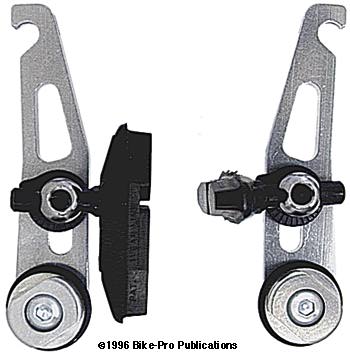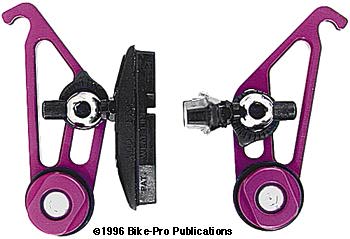Brake Systems
- Brake/Shift Levers
- Caliper Brakes (Road)
- Cantilever Brakes (MTB)
- Brake Levers
- Brake Shifter Combination Levers
- Brake Boosters
- Brake Cables
- Brake Carriers
- Brake Hangers
- Brake Pads
- Titanium Brake Hardware
Computers
Cranks and Chainrings
Forks
Frames & Framesets
Freewheels and Cassettes
Front Derailleurs
Grips
Handlebars
Handlebar Extensions
Headsets
Helmets
Hubs and Skewers
Lubricants
Metal Guide - Bicycle Metallurgy
Mirrors
Pedals and Toe Clips
Pumps and Inflation Systems
Racks
Rear Derailleurs
Rims & Rimstrips
Saddles
Seatposts and Binder Bolts
SRP Replacement Titanium &
Aluminum parts - Master Index
Stems
Tires
Tubes
Shoes
Spokes (Tables Only)
Tools - Bicycle Repair Tools
Yakima Fit List -to fit all cars
Notes
Links
Home
Prototype Machining Joe's Cantilever Brake
PROTOTYPE MACHINING JOE'S CANTILEVER BRAKE
The Joe's cantilever is made of machined aluminum plate stock and comes as a front or a rear brake. The difference between the two is the structure and width of the arm.
Mechanical explanation of the Joe's Brake. The arms are milled from 6.5mm thick bar stock. At the center of the mounting stud they are 21.5mm wide. The front brake arm narrows to 19mm at a point 50mm from the bottom of the arm, then curves outward slightly and narrows to 13mm at the top of the arm. The front brake arm has an overall length of 100mm. The rear arm widens to 28.5mm at 43mm from the bottom, then turns outward and narrows to 13mm at the top of arm. The rear arm style has a 78mm overall height. The front arm type has two slots milled out of it. The one in the lower section of the arm is 6.68mm wide and 24mm long for the brake pad holder assembly to adjust and bolt through. The one in the upper section is a triangular shape with a 10mm base, 6.35mm width at the top and a 23mm height. This is cut away is reduce weight.
The rear arm has the same brake pad slot milled away and has a larger triangular one cut to reduce weight out the wide area of the arm. The cut is 20mm wide with a 6.35mm wide point and roughly 42mm length. The base of the arm has a brass tube machine pressed through it for the brake to pivot around. From the outer side of the arm a small hole is drilled through the aluminum and through the brass tube. A machined stainless steel bushing is placed inside the brass tube from the bottom. This steel tube slides over the brake mounting stud, and the hole from the side allows lubricant under pressure in to lubricate the common surface between the brass and steel bushing. Each of the internal tension springs is independently adjustable. A single small hole through the arm at the top of the top of the brass piece seats one end of the brake spring. A small serrated washer closes off the very small gap between the brass and steel bushings at the top.
A machined from aluminum rod tension adjusting cap slides over the spring assembly. It has a small hole inside for the other spring end to seat in, and has parallel cuts made to grip for a 15mm wrench to turn. After turning the spring adjusting cap to develop the proper spring tension, the mounting bolt is tightened down holding the spring tension while allowing the brake arm to pivot smoothly. The center of the adjusting cap is bored with a 10.65mm by 3.25mm hole to recess the mounting bolt. To reduce the friction at the bottom of the arm as it pivots a 1/4" (6.35mm) thick Delrin washer lifts the brake and makes a smooth gliding surface. Six steel parts are involved in holding and positioning the brake pads. The pad holder (eyebolt) is bulb shaped steel with a 5mm hex fitting to make final adjustments. We found all three of the SRP Titanium replacements worked in place of this steel model, because of its size and weight the short shank bulb shape (our part # 06-91-PH) would be our choice.
Beneath the pad holder is stamped steel "toe-in adjuster", then the brake arm, then two stamped steel washers, a friction reducing steel washer and a steel nut. None of the six of these steel pieces is at all impressive in workmanship, precision or quality of finish, and they are used by others. They are imported from Taiwan, and look like they were made in one of the factories responsible for the little brass incense burners that were so popular in the 1970's. It's unfortunate that so many other aspects of these are brakes are given careful consideration and these get overlooked. The brake comes with a 300mm long Dia-Compe straddle cable. The cable has a lead anchor at one end and at the same end a lead finger grip for quick release purposes. The anchor for the other end is a cable end clamp machined from steel. The clamp looks like a tube with interior threads. The straddle cable passes through the sides of the tube and a cap screw through the middle tightens the clamp in place. Each Joe's Brake come with a Joe's Yoke for a cable carrier. Machined from aluminum plate, these cable carriers are also sold as an after market replacement carrier and are reviewed in detail elsewhere in this article. The brake comes with mounting bolts and brake pads. The mounting bolts are made of cadmium plated steel with 6mm by 1mm threads and an 11mm length. They have a 4mm hex fitting and each weigh 3.25 grams. End of Mechanical.
The brake pads included are Black Kool-Stop Eagle Claws, but they have a steel instead of the standard aluminum mounting post making the pair of brake pads weigh 46.5 grams. We found the front Joe's brake had a Bike-Pro brake profile measurement of 41mm, the rear model is wider with a 77mm measurement. The front Joe's brake weighs 169 grams (46.5 grams are the brake pads). The rear Joe's Brake weighs less at 160 grams because of the shorter arms and its being more extensively milled out. To each of these weights add 6.5 grams for the mounting bolts and 9 grams for the cable carrier leaving us with 184.5 grams total weight for the front and 175.5 grams for the rear. The Joe's Brake has the arms and adjusting caps anodized in Blue, Black, Lavender or Silver. Specify front or rear and color. Made in USA.
Two ex-Bell Sports employees bought Mantis and several other bicycle parts companies, Joe's , Critical, and Carmichael. Joe's brake design were retired and they have chosen to market the Critical Brakes instead.



